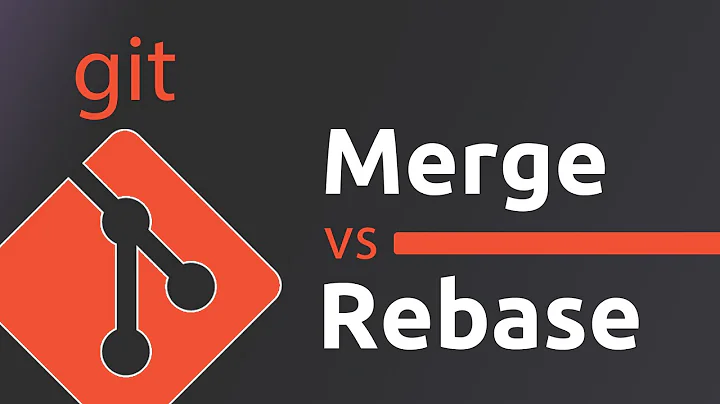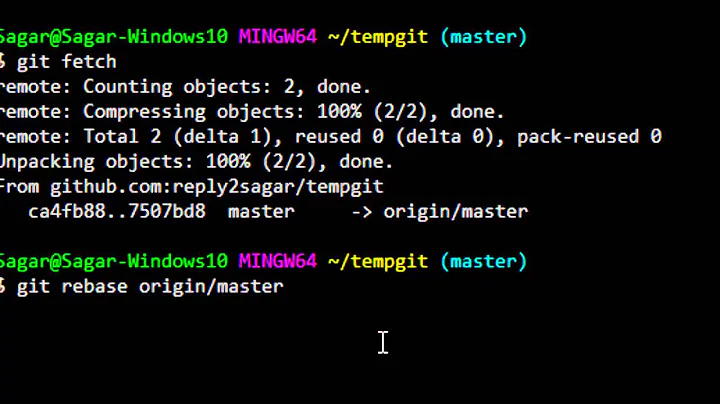Git: Pulling a rebased branch
Solution 1
My recommendation (or, "what I would do if I were Mr Orange") is, start with git fetch. Now I'll have this in my repo, which is what Mr Blond had after his rebase and just before he ran "git push -f".
M1 - M2 - M3
\ \
\ \
A1 - A2 A1' - A2'
The one important difference is, I'll have my local label A pointing to rev A2, and the remote label remotes/origin/A pointing to A2' (Mr Blond had it the other way around, local label A pointing to A2' and remotes/origin/A pointing to A2).
If I've been working on my copy of the branch named "A" I'll have this instead:
M1 ---- M2 ---- M3
\ \
\ \
A1 - A2 - A3 A1' - A2'
(with my local label pointing to A3 rather than A2; or A4 or A5, etc, depending on how many changes I have applied.) Now all I have to do is rebase my A3 (and A4 if needed, etc) onto A2'. One obvious direct way:
$ git branch -a
master
* A
remotes/origin/master
remotes/origin/A
$ git branch new_A remotes/origin/A
$ git rebase -i new_A
and then drop revs A1 and A2 entirely, since the modified ones are in new_A as A1' and A2'. Or:
$ git checkout -b new_A remotes/origin/A
$ git format-patch -k --stdout A3..A | git am -3 -k
(the git am -3 -k method is described in the git-format-patch manual page).
These do require figuring out what I have that Mr Blond didn't before he did his rebase, i.e., identifying A1, A2, A3, etc.
If the second approach is successful I end up with:
M1 ---- M2 ---- M3
\ \
\ \
A1 - A2 - A3 A1' - A2' - A3'
where my branch name new_A points to A3' (my existing A branch still points to the old A3). If I use the first approach and it succeeds, I end up with the same thing, it's just that my existing branch name A will now point to A3' (and I have no name for the old branch with A1-A2-A3, even though it's still in my repo; finding it requires going through reflogs or similar).
(If my A3 needs modification to become A3', both the interactive rebase and the "git am" method will require work by me, of course.)
Of course it's also possible to just git merge (as in the answer by Gary Fixler), but that will create a merge commit ("M" with no number, below) and keep revs A1 and A2 visible, giving:
M1 ---- M2 ---- M3
\ \
\ \
A1 - A2 - A3 A1' - A2' -- M
\_______________/
If you want to preserve the original A1 and A2, this is a good thing; if you want to get rid of them, it's a bad thing. So "what to do" depends on "what you want the result to be".
Edit to add: I like the format-patch method better as it leaves my old A branch name around while I make sure everything is good. Assuming it all works and is good, here's the last few steps:
$ git branch -m A old_A
$ git branch -m new_A A
and then, if old_A can be abandoned entirely:
$ git branch -D old_A
or, equivalently, start with the branch delete, then rename new_A to A.
(Edit: see also git rebase --onto documentation, for the goal of rebasing A3, etc., onto the new_A branch.)
Solution 2
If Mr. Orange doesn't mind losing his changes, he can fetch from the server, then git checkout A to get onto his local A branch, then (presuming the remote is named "origin") git reset --hard origin/A to reset his A to where the remote's A is.
If he is concerned with losing changes, he can merge the server's changes in to resolve them (from his own A branch, and presuming again that the remote is named "origin") with git merge origin/A. This will make a new commit that's on top of both his and the remote's A branches with the changes from both merged together. Then this can be pushed back to the remote.
Solution 3
I develop concurrently on two virtual machines, for configuration purposes. As a result, I frequently rebase on one machine and need the changes to appear on the other without difficulty.
Suppose my branch is named feature/my-feature-branch. After finishing the rebase on the first VM, I do a git fetch on the second. The following message appears:
$ git status
On branch feature/my-feature-branch
Your branch and 'origin/feature/my-feature-branch' have diverged,
and have 21 and 24 different commits each, respectively.
(use "git pull" to merge the remote branch into yours)
Well, don't do a git pull, because then you end up with a meaningless merge commit after quite a bit of fussing.
Instead, run
git rebase -i origin/feature/my-feature-branch
Once the text editor pops up, delete all commits, and replace it with the following (this makes it so the rebase completes without any commits being kept).
exec echo test
If you do have commits that need to be kept, then those can be applied here. In either case, the rebase will complete, and now both machines are in sync again, as evidenced by:
$ git pull
Already up-to-date.
$ git push
Everything up-to-date
Solution 4
TLDR
Unless I have misunderstood the question, the answer is for Mr Orange to git pull --rebase.
Longer read
Simple case
If we assume that the changes made by A1 and A2 are the same as A1' and A2' (even if their commit hashes aren't the same) then Mr Orange can go from having
M1 - M2 - M3
\
\
A1 - A2
locally to having
M1 - M2 - M3
\
\
A1` - A2`
by either doing
git pull --rebase
or
git branch -d A
git checkout A
A more interesting case
If we assume, as above, that the changes made by A1 and A2 are the same and that Mr Orange has made an extra commit then he will locally have
M1 - M2 - M3
\
\
A1 - A2 - A3O
and origin will be
M1 - M2 - M3
\
\
A1` - A2`
and, again, Mr Orange can get to
M1 - M2 - M3
\
\
A1` - A2` - A3O
with
git pull --rebase
A more realistic case
If we assume, as above, that the changes made by A1 and A2 are the same, that Mr Orange has made an extra commit and that Mr Blonde has made an extra commit then Mr Orange will have this locally
M1 - M2 - M3
\
\
A1 - A2 - A3O
and, assuming Mr Blonde has pushed, origin will be
M1 - M2 - M3
\
\
A1` - A2` - A3B
and Mr Orange can get to
M1 - M2 - M3
\
\
A1` - A2` - A3B - A3O
by doing
git pull --rebase
though, this time, he may need to fix conflicts.
Related videos on Youtube
Itai Hanski
Updated on August 06, 2021Comments
-
Itai Hanski over 2 years
Let me describe my situation:
Mr Blond and Mr Orange are working on branch A that branches out of the master branch on commit M1. Branch A has 2 commits: A1 and A2.
M1 \ \ A1 - A2Meanwhile, Mr Orange committed and pushed 2 more commits on the master branch, M2 and M3.
M1 - M2 - M3 \ \ A1 - A2Mr Blond pulls from the remote, and after a while decides to rebase onto the master branch:
M1 - M2 - M3 \ \ \ \ A1 - A2 A1` - A2`Now A1` and A2` are the rebased commits that exist locally at Mr blond's, and A1 and A2 exist remotely. Mr Blond pushes his commits, using -f to force his changes and "rewrite" history. Now the remote repository looks like this:
M1 - M2 - M3 \ \ A1` - A2`But Mr. Orange worked on the A branch as well. His local repository still looks like this:
M1 - M2 - M3 \ \ A1 - A2What does Mr. Orange need to do in order to be synchronized with A branch in the remote repository?
A normal pull won't work. Will pull -f force the changes from the remote locally? I know that deleting the local version of A and bringing it again from the remote repository will do the trick but that doesn't seem to be a good way to achieve that.
-
qbolec almost 7 yearsNote: there is no whitespace between
--andhard- it took me a while, as the answer was wrapped on my screen precisely between those two:) -
 Evan Nagle about 6 yearsIf there are no changes to track, it might also be just as easy to delete the local branch; fetch from the remote; and then checkout the newly fetched branch again.
Evan Nagle about 6 yearsIf there are no changes to track, it might also be just as easy to delete the local branch; fetch from the remote; and then checkout the newly fetched branch again. -
 Mike Moore almost 6 yearsI like this solution, especially when you may have already fetched updates from the origin, so it just resets the local ref for the branch without making another network request.
Mike Moore almost 6 yearsI like this solution, especially when you may have already fetched updates from the origin, so it just resets the local ref for the branch without making another network request. -
 Khouri Giordano over 4 yearsThat should probably be
Khouri Giordano over 4 yearsThat should probably beorigin/Anotorigin/A2sinceA2referred to a commit, not a branch. -
 Akash Agarwal about 3 yearsThis is the perfect answer. I would like to point out that you may also choose to "drop" all of the commits in the last step, instead of running
Akash Agarwal about 3 yearsThis is the perfect answer. I would like to point out that you may also choose to "drop" all of the commits in the last step, instead of runningexec echo test, not that it makes any difference than deleting the commit lines. -
Christian about 2 yearsThis should be the accepted answer. I don't know if Git improved so much since Gary Fixler's answer from 2013, but nowadays it doesn't seem to be an issue anymore to rebase a published branch.
-
Christian about 2 yearsI think this answer is outdated. "git pull --rebase" can handle the situation just fine.





